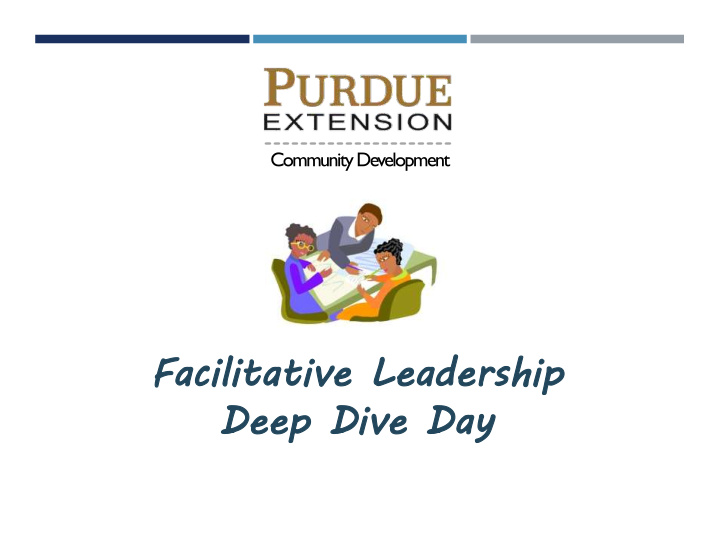



Community Development Faci acilitati itative ve Leade adersh rship ip De Deep Di Dive Da Day
INTRODUCTIONS Kris Parker Tamara Ogle Purdue Extension Community Development Andrea Proulx Buinicki Giving Focus
TWO-MINUTE CONVERSATIONS ACTIVITY
Understand facilitative leadership Share tips for leading effective meetings Practice using some basic tools Gain confidence to lead groups effectively
WHAT IS FACILITATION? The design and management of structures and processes that help a group: Work together successfully. Identify and minimize problems. Increase effectiveness. (Justice and Jamieson, 1998)
WHAT IS A FACILITATOR’S JOB? “A facilitator’s job is to support everyone to do their best thinking” ~Sam Kaner “ A facilitator’s job is to manage the process FACILITATOR: GROUP: and leave the content PROCESS CONTENT Kris Parker to the participants .” ~Ingrid Bens
PROCESS VS. CONTENT Process Content
PROCESS VS. CONTENT Facilitator Process Coach Expert Content
PROCESS VS. CONTENT Facilitative Facilitator Leader Process Learning Coach Facilitator Trainer Expert Content
FOUR FUNCTIONS OF A FACILITATOR ► Encouraging full participation ► Promoting mutual understanding ► Fostering inclusive solutions ► Cultivating shared responsibility Kaner, Sam, Lenny Lind, Catherine T oldi, Sarah Fisk, and Duane Berger. Facilitator's Guide to Participatory Decision-making . 2nd ed. San Francisco, CA: Jossey-Bass, 2007. Print.
FACILITATING FOR COMMUNITY FOUNDATIONS Leading Coalition Meetings Facilitating Visioning or Strategic Planning Convening Community Conversations Managing a Project Other? FACILITATION AT A GLANCE, INGRID BENS (2012).
FACILITATION LEARNING LAB
FLIP CHARTS Using Flip Charts Activity
QUESTIONS?
INTERNAL OR EXTERNAL?
WHEN TO USE AN INTERNAL FACILITATOR Advantages Challenges Understand organization’s May lack experience or tools history and culture May not be seen as credible Stake in success May not be seen as neutral Available, salaried May have some bias towards Aware of resources outcomes Can follow outcomes and ensure Situation to risky, facilitator has continuity to deal with fallout FACILITATION AT A GLANCE, INGRID BENS (2012).
WHEN TO USE AN EXTERNAL FACILITATOR Advantages Challenges Assumed to be credible Need to research extensively May have specialized experience Don’t fully understand personalities involved People may trust neutrality Need to build rapport with client Unencumbered by political or emotional baggage Don’t get to see initiatives unfold Can afford to take more risks Can be costly Can walk away from repercussions May be unavailable for follow-up work Paid, high expectations FACILITATION AT A GLANCE, INGRID BENS (2012).
WHEN TO BE DIRECTIVE OR FACILITATIVE Be DIRECTIVE and act like Be FACILITATIVE for the a meeting chair: sections of the meeting: To gain input of team members To give clear instructions To create more buy-in and To share your expertise commitment To inform people about To encourage staff to take the decisions already made lead When there is no input on non- When accountability is shared negotiable situations When the ideas of staff are When accountability is not needed shared FACILITATION AT A GLANCE, INGRID BENS (2012).
WHEN MIGHT YOU USE FACILITATION?
EXAMPLES Can you think of a situation that benefitted from (or could have benefitted from) facilitation?
WHAT ARE YOUR GROUPS DECIDING?
THE GROUP DECISION-MAKING PROCESS Kaner, Sam, Lenny Lind, Catherine T oldi, Sarah Fisk, and Duane Berger. Facilitator's Guide to Participatory Decision-making . 2nd ed. San Francisco, CA: Jossey-Bass, 2007. Print.
IDEA GENERATING Brainstorming Popcorn Round Robin Sticky Note Cards Mind Map Rotating Flip Charts Fishbone Diagram
CALCULUS OF DIVERSITY People often listen to or take more seriously the ideas that are expressed in acceptable communication styles. Role of a Facilitator Groups may ignore an idea from speaker who is The facilitator can help the Repetitive group expand the number Shy or anxious of ideas it “hears”. Exaggerates or distorts Emotional
NARROWING Sticky Dot Voting Paired Comparisons Rank Voting Quadrant Diagram Decision Matrix
USING A “PARKING LOT” LIST This is where you park ideas or topics when now is not the right time to address them
TOOLKIT
QUESTIONS?
FACILITATION REQUIRES EXPERTISE Learning How to improve? Read about facilitation best practices Knowledge Attend further training Build your “tools” Skills Develop verbal/ nonverbal skills for facilitation Set learning goals Attitude Work to build a culture of facilitation Embody core principles of facilitation Ethics Reflect and seek feedback T eam up with an experienced facilitator Experience Take on small facilitation opportunities
Learn more with Purdue Extension Community Development at www.cdext.purdue.edu Facilitative Leadership June 26-28, 2018 Nashville, Indiana
Community Development Th Than ank k you ou! Kris Parker Andrea Proulx Buinicki Tamara Ogle parkerkj@purdue.edu andreapb@giving-focus.com togle@purdue.edu
Recommend
More recommend